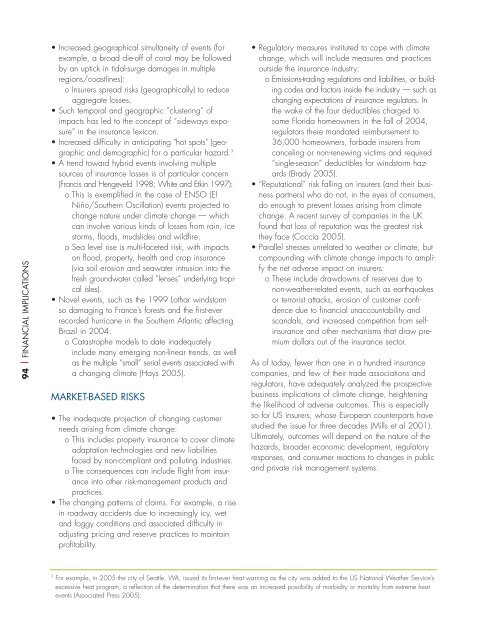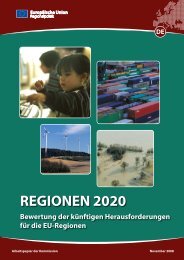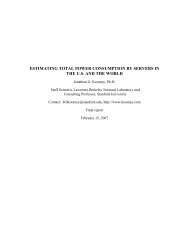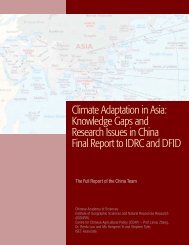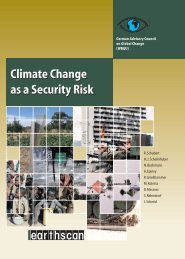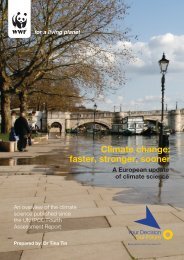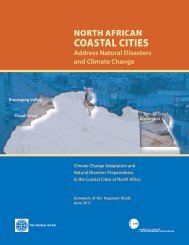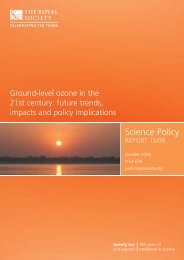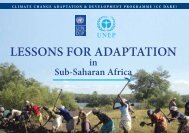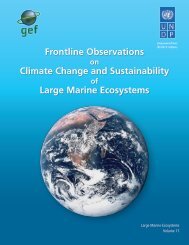Climate change futures: health, ecological and economic dimensions
Climate change futures: health, ecological and economic dimensions
Climate change futures: health, ecological and economic dimensions
Create successful ePaper yourself
Turn your PDF publications into a flip-book with our unique Google optimized e-Paper software.
94 | FINANCIAL IMPLICATIONS• Increased geographical simultaneity of events (forexample, a broad die-off of coral may be followedby an uptick in tidal-surge damages in multipleregions/coastlines):o Insurers spread risks (geographically) to reduceaggregate losses.• Such temporal <strong>and</strong> geographic “clustering” ofimpacts has led to the concept of “sideways exposure”in the insurance lexicon.• Increased difficulty in anticipating "hot spots" (geographic<strong>and</strong> demographic) for a particular hazard. 3• A trend toward hybrid events involving multiplesources of insurance losses is of particular concern(Francis <strong>and</strong> Hengeveld 1998; White <strong>and</strong> Etkin 1997):o This is exemplified in the case of ENSO (ElNiño/Southern Oscillation) events projected to<strong>change</strong> nature under climate <strong>change</strong> — whichcan involve various kinds of losses from rain, icestorms, floods, mudslides <strong>and</strong> wildfire.o Sea level rise is multi-faceted risk, with impactson flood, property, <strong>health</strong> <strong>and</strong> crop insurance(via soil erosion <strong>and</strong> seawater intrusion into thefresh groundwater called “lenses” underlying tropicalisles).• Novel events, such as the 1999 Lothar windstormso damaging to France’s forests <strong>and</strong> the first-everrecorded hurricane in the Southern Atlantic affectingBrazil in 2004:o Catastrophe models to date inadequatelyinclude many emerging non-linear trends, as wellas the multiple “small” serial events associated witha changing climate (Hays 2005).MARKET-BASED RISKS• The inadequate projection of changing customerneeds arising from climate <strong>change</strong>:o This includes property insurance to cover climateadaptation technologies <strong>and</strong> new liabilitiesfaced by non-compliant <strong>and</strong> polluting industries.o The consequences can include flight from insuranceinto other risk-management products <strong>and</strong>practices.• The changing patterns of claims. For example, a risein roadway accidents due to increasingly icy, wet<strong>and</strong> foggy conditions <strong>and</strong> associated difficulty inadjusting pricing <strong>and</strong> reserve practices to maintainprofitability.• Regulatory measures instituted to cope with climate<strong>change</strong>, which will include measures <strong>and</strong> practicesoutside the insurance industry:o Emissions-trading regulations <strong>and</strong> liabilities, or buildingcodes <strong>and</strong> factors inside the industry — such aschanging expectations of insurance regulators. Inthe wake of the four deductibles charged tosome Florida homeowners in the fall of 2004,regulators there m<strong>and</strong>ated reimbursement to36,000 homeowners, forbade insurers fromcanceling or non-renewing victims <strong>and</strong> required“single-season” deductibles for windstorm hazards(Brady 2005).• “Reputational” risk falling on insurers (<strong>and</strong> their businesspartners) who do not, in the eyes of consumers,do enough to prevent losses arising from climate<strong>change</strong>. A recent survey of companies in the UKfound that loss of reputation was the greatest riskthey face (Coccia 2005).• Parallel stresses unrelated to weather or climate, butcompounding with climate <strong>change</strong> impacts to amplifythe net adverse impact on insurers:o These include drawdowns of reserves due tonon-weather-related events, such as earthquakesor terrorist attacks, erosion of customer confidencedue to financial unaccountability <strong>and</strong>sc<strong>and</strong>als, <strong>and</strong> increased competition from selfinsurance<strong>and</strong> other mechanisms that draw premiumdollars out of the insurance sector.As of today, fewer than one in a hundred insurancecompanies, <strong>and</strong> few of their trade associations <strong>and</strong>regulators, have adequately analyzed the prospectivebusiness implications of climate <strong>change</strong>, heighteningthe likelihood of adverse outcomes. This is especiallyso for US insurers, whose European counterparts havestudied the issue for three decades (Mills et al 2001).Ultimately, outcomes will depend on the nature of thehazards, broader <strong>economic</strong> development, regulatoryresponses, <strong>and</strong> consumer reactions to <strong>change</strong>s in public<strong>and</strong> private risk management systems.3For example, in 2005 the city of Seattle, WA, issued its first-ever heat warning as the city was added to the US National Weather Service’sexcessive heat program, a reflection of the determination that there was an increased possibility of morbidity or mortality from extreme heatevents (Associated Press 2005).


